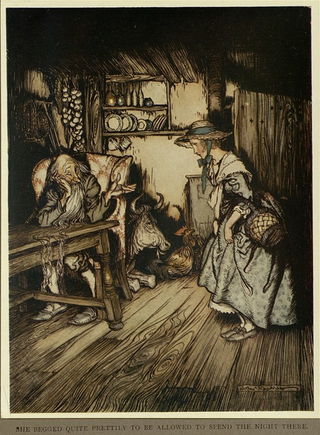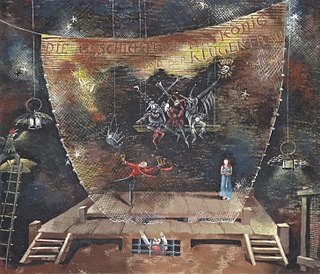
"Hansel and Gretel" is a German fairy tale collected by the Brothers Grimm and published in 1812 as part of Grimms' Fairy Tales.

Little Red Riding Hood is a European fairy tale about a young girl and a sly wolf. Its origins can be traced back to several pre-17th-century European folk tales. The two best known versions were written by Charles Perrault and the Brothers Grimm.

"The Elves and The Shoemaker" is a set of fairy tales collected by the Brothers Grimm about a poor shoemaker who receives much-needed help from three young helpful elves.
Prince Charming is a fairy tale stock character who comes to the rescue of a damsel in distress and must engage in a quest to liberate her from an evil spell. This classification suits most heroes of a number of traditional folk tales, including "Snow White", "Sleeping Beauty", "Rapunzel" and "Cinderella", even if in the original story they were given another name, or no name at all.
Farmer Weathersky is a Norwegian fairy tale collected by Peter Chr. Asbjørnsen and Jørgen Moe in Norske Folkeeventyr.

The Two Brothers is a German fairy tale collected by the Brothers Grimm, tale number 60. It is Aarne-Thompson type 303, "The Blood Brothers", with an initial episode of type 567, "The Magic Bird Heart". A similar story, of Sicilian origin, was also collected by author and folklorist Andrew Lang in The Pink Fairy Book.

"The Hut in the Forest" is a German fairy tale collected by the Brothers Grimm. Andrew Lang included it in The Pink Fairy Book (1897). It is Aarne-Thompson type 431.

The Magical Legend of the Leprechauns is a 1999 fantasy television miniseries. It stars Randy Quaid, Colm Meaney, Kieran Culkin, Roger Daltrey, Caroline Carver and Whoopi Goldberg. The miniseries contains two main stories that eventually intertwine: the first being the story of an American businessman who visits Ireland and encounters magical leprechauns and the second, a story of a pair of star-crossed lovers who happen to be a fairy and a leprechaun, belonging to opposing sides of a magical war. The series contains many references to Romeo and Juliet, such as two lovers taking poison and feuding clans.
The White Doe or The Doe in the Woods is a French literary fairy tale written by Madame d'Aulnoy. Andrew Lang included it in The Orange Fairy Book.
Molly Whuppie is an English language fairy tale set in Scotland. It was first published in 'Three Folk-Tales from Old Meldrum, Aberdeenshire' in "Folklore" (6.2.1884). Rev. Walter Gregor said that the tales had been 'communicated to me by Mr. Moir, Rector of the Grammar School, Aberdeen. He had them from his mother, who kindly wrote out " Mally Whuppie " and " The Red Calf" at my request.' Anglicising the name to "Molly" from "Mally" Joseph Jacobs used this source of the story in his English Fairy Tales. A Highland version, Maol a Chliobain, was collected by John Francis Campbell in Popular Tales of the West Highlands. Jacobs noted the relationship between the two tales, and an Irish variant, "Smallhead," and concluded that the tale was Celtic in origin.
The Snake Prince is an Indian fairy tale, a Punjabi story collected by Major Campbell in Feroshepore. Andrew Lang included it in The Olive Fairy Book (1907).
One Life to Live is an American soap opera that was broadcast on the ABC network from July 1968 to January 2012, and online from April to August 2013. The series starts with One Life to Live storylines (1968–79). The plot continues in One Life to Live storylines (1980–89). The plot in the next decade is outlined in One Life to Live storylines (1990–1999) and the story concludes in One Life to Live storylines (2000–2013).

Die Kluge. Die Geschichte von dem König und der klugen Frau is an opera in 12 scenes written by Carl Orff. It premiered at the Frankfurt Opera, Germany, on 20 February 1943. Orff referred to this opera as a Märchenoper. The composer also wrote the libretto, based on "Die Kluge Bauerntochter" from Grimms' Fairy Tales. A performance lasts for about 90 minutes and is often paired with Orff's Der Mond.

Gigi Morasco is a fictional character on the ABC soap opera One Life to Live. She was portrayed by Farah Fath from October 24, 2007, through January 12, 2012.

Alex Gwendolyn Olanov is a fictional character from the long-running ABC soap opera One Life to Live. She was portrayed by Tonja Walker since the character's inception in 1990 to 1997, with appearances in 2001, 2002, 2007, 2009, and 2011.

"Jack and the Beanstalk" is an English fairy tale. It appeared as "The Story of Jack Spriggins and the Enchanted Bean" in 1734 and as Benjamin Tabart's moralized "The History of Jack and the Bean-Stalk" in 1807. Henry Cole, publishing under pen name Felix Summerly, popularized the tale in The Home Treasury (1845), and Joseph Jacobs rewrote it in English Fairy Tales (1890). Jacobs' version is most commonly reprinted today, and is believed to be closer to the oral versions than Tabart's because it lacks the moralizing.

Cinderella is a 1914 silent film starring Mary Pickford, directed by James Kirkwood Sr., produced by Daniel Frohman, and released by Famous Players Film Company. The film is based upon the fairy tale Cinderella. The film was released on Blu-ray & DVD as a bonus feature from the DVD of Through the Back Door (1921). It was previously released on DVD by Alpha Video.

The Russian folklore, i.e., the folklore of Russian people, takes its roots in the pagan beliefs of ancient Slavs and now is represented in the Russian fairy tales. Epic Russian bylinas are also an important part of Slavic paganism. The oldest bylinas of Kievan cycle were recorded in the Russian North, especially in Karelia, where most of the Finnish national epic Kalevala was recorded as well.

The Adventures of Pinocchio is a 1972 Italian five-part miniseries directed by Luigi Comencini, which originally aired weekly on Rai 1 between April 8 and May 6, 1972. Based on Carlo Collodi's 1883 novel with the same name, the miniseries received a large critical success, and had an average of twenty-one and a half million viewers during its first airing. All the episodes together make up 280 minutes of runtime.












